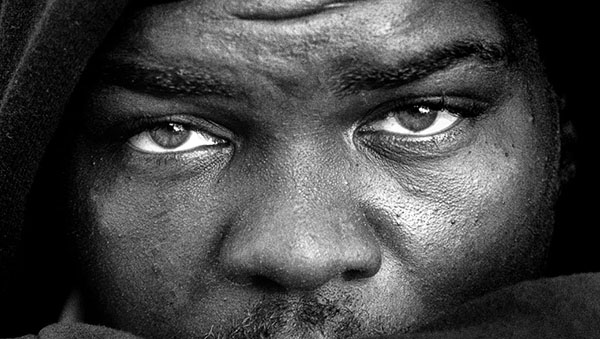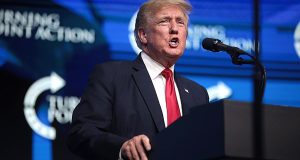By Yvonne Sam
Social and Political Commentator
 From the outset, it is a known fact that police brutality does not burden all racial groups equally. The disproportionate killing of black people is not a new phenomenon.
From the outset, it is a known fact that police brutality does not burden all racial groups equally. The disproportionate killing of black people is not a new phenomenon.
On December 9, 1948, the Genocide Convention, Article 2, adopted by the General Assembly of the United Nations, thus defined genocide: “any of the following acts, committed with intent to destroy, in whole or in part, a national, ethnical, racial or religious group, as such: killing members of the group; causing serious bodily or mental harm to members of the group” treaties.un.org/doc/publication/unts/volume%2078/volume-78-i-1021-english.pdf
Based on this definition, I am arguing that Blacks in America, especially males, are victims of genocide, by virtue of the consistent, conscious and unified actions of the police.
When I, daresay, will these senseless tragedies — this genocide that has been taking place with calculated intensity — find a solution? Blacks are no strangers to what happens next, simply because this brand of tragedy has become so routine. Videos of the deaths have only allowed us to bear witness, but it has not, and will not, bring justice.
The greatest respect for humanity requires that we reject, in the strongest terms, the unconscionable and unjustified taking of life. Daily, and earnestly, I search for answers to the “why” of their senseless executions and the reason and/or rationale that after so many centuries, America still sustains a level of racial hatred and intolerance that fuel these acts of violence
I am frequently reminded of the old adage, that one can only beat a dog for so long before the canine attacks, out of the rage and frustration of receiving needless beatings. Unlike the time when some Blacks were conditioned into accepting the indignities of discrimination, just “as a matter of the way things were”, most Black people, now, are no longer willing to accept these indignities that accumulate in their psyches and eventually distort their relationships with others and their place in the world. Some of them are more inclined to strike back in ways — futile as they might be — that they believe will express the full scope of their collective rage and frustration, and bring some measure of justice and retribution against those who inflict harm.
Investigations continue to seek a rationale for why, when interacting with police, Black folks, especially males, do not survive. I am personally dichotomized, trying to suppress my grief and outrage and, at the selfsame time, thinking of change. “I can’t breathe”, trying to believe that change is possible, when with alarming frequency and recurring evidence show me otherwise.
Do these deaths signify the white-hooded, cross-burning, racist philosophical figures of the past, evolved to a different cloak of disguise — effectively hidden by the blue uniforms they wear? The truth may possibly lie in the saying, that the more things change, the more they remain the same.
Stephon Clark, a 22-year-old male was killed on the evening of March 18, in his grandmother’s backyard in Sacramento, California. The police mistook his cellphone for a firearm, causing him to be shot at, 20 times. Videos show that after the shooting, the police held off from approaching Clark’s body for about five minutes, and once they approached him, he was handcuffed and searched for nearly a minute before rescue assistance began.
On April 4, on a Brooklyn street corner, New York City police officers shot and killed Saheed Vassell, a black man, who was known to be mentally ill, after he pointed what the officers believed was a gun at them. The object, however, turned out to be a metal pipe with a knob on it.
Four officers discharged 10 rounds, with one striking the victim in the head.
June 6, while in police custody, and being transferred to the main jail for booking, parolee, Brandon Smith, died. In a video, released by the Sacramento Police Department, the victim could be seen telling state and local law enforcement officers he felt like he was having a heart attack.
On June 19, in Pennsylvania, 17-year-old Antwon Rose, an African American, was fatally shot, three times, in the back, when he ran from police, who had stopped the car in which he was a passenger. The vehicle matched the description of a car, in connection with a shooting in a nearby community. When the driver was stopped and ordered out of the car, Rose and a second unidentified passenger bolted. The officers involved were not wearing body cameras, nor was the police vehicle equipped with any cameras. The officer who fatally shot Rose — identified as Michael Rosfeld — has been charged with homicide
In Minneapolis, Thurman Blevins, a 31-year-old Black man, was shot, multiple times, by police. According to the police, the fateful saga began when an anonymous caller reported a man was walking around with a gun, on the 4700 block of Bryant Avenue North. The caller “provided very detailed information about the appearance and descriptions”, according to an Minneapolis Police Department (MPD) spokesperson. Police then received a second call, of a person walking and firing a silver 9mm handgun into the air and subsequently into the ground. The victim was reportedly sitting with a woman near the intersection of 48th and Camden Avenues North, when officers arrived, and ran away as they began exiting their vehicles.
These killings have proven that Blacks live in an era when the word unarmed is becoming insignificant and for a black man in certain settings, inconsequential.
Color-blindness is the social cataract that makes America visionless to the reality of race, and thus, the possibility of pain. Too many whites feign ignorance of racial discrimination that impact Black communities, and that these acts are nothing more than isolated incidents, which have little or no connection to a larger reality. They don’t see that with each act of racial injustice or violence, there’s a corresponding increase in the level of anger in communities. They see Black communities disconnected by geography, but fail to see that notwithstanding, Blacks are connected by an understanding of the common potential as victims of the same injustice. America has always relied on black forgiveness to absolve itself of white guilt.
Sarah Sanders, White House spokesperson, said that the Clark shooting was a “local matter”, an assessment that was met with outrage by Blacks all over America. Unarmed black people are killed by police in enough states across the United States, with enough frequency, for this to be examined at the federal level, opined Congressional Black Caucus chairman, Cedric Richmond.
True and not new: racism and ill-will behind the intent to kill
New technologies on the scene, from police dash and body cameras, to cellphones and social media have been effective in shining a conspicuous light on the words and deeds of some officers.
Todd Shaw, Assistant Police Chief in Prospect, Kentucky, resigned, last year, after sending disturbing Facebook messages, described by a county official as highly disturbing and threatening. According to news reports, during discussions of the right response if juveniles were caught smoking marijuana, Shaw purportedly told a recruit, “F…. the right thing. If black, shoot”. As to the manner of dealing with teenagers’ parents, he further instructed the recruit to have sex with both of them. “Unless daddy is black. Then shoot him”. According to news reports, Shaw also wrote Facebook messages saying that public housing projects should be levelled; allegedly wrote derogatory messages about Dr. Martin Luther King Jr., adding, “because someone shot him, I get a day off with pay each year so I will take it”. www.cnn.com/2018/01/22/us/kentucky-officer-urged-recruit-to-shoot-blacks/index.html
It is blatantly apparent that the hateful mentality seen in those messages is, in no way, different from the mentality of lynching parties of time gone by, that hanged blacks from trees for sport. The only difference being that today’s racists are not ignorant thugs, but so-called sworn defenders of the law, authorized by society to carry guns. How many more are there in the ranks who think like Shaw?
De-escalation must be done before reaching for the gun
Every year, around 1,000 people are shot and killed by police, according to the police databases. Of those victims, more than half were wielding guns, leaving officers few choices in how to respond. Mental illness has played a significant role in many of the incidents, played out on American streets, involving Blacks and the police.
In the U. S some police departments offer de-escalation training to their officers, teaching them to defuse potentially dangerous situations and get armed individuals to lay down their weapons. However, in 34 states, training decisions are left to local agencies. Most, though, conduct none, or very little de-escalation training. Police Chiefs cite cost, lack of staff, and a belief that the training is not needed. and constitutes a rebuke of traditional policing. theintercept.com/2017/11/09/baltimore-police-deescalation-video/
Limiting the dead — progress ahead? Having a say the English way
As police officers continue to kill black Americans with impunity, a host of reforms in police training, concerning use of force, have been proposed. Similar to gun violence itself, police brutality in the United States remains stuck on repeat.
A recently published book, “The End of Policing”, by Alex Vitale, professor of sociology and coordinator of the Policing and Social Justice Project at Brooklyn College, is an essential primer to unpack the innate brutality of policing and begin to envision an America, free from police violence and control.
Executive Director of the Police Executive Research Forum (PERF), Chuck Wexler, is currently seeking to establish a national de-escalation model, based on the National Decision Making Model (NDM) used in the United Kingdom. This is a framework that emphasizes communication, patience, and minimal force, and helps officers to respond effectively to all sorts of situations and problems. In the U. K, police place a high priority on learning how to resolve incidents without using firearms, because the large majority of constables there, are not equipped with firearms.
The kind of policies, the kind of training, tactics, and culture that we are talking about are really significant changes to the way we think. Given all the facts, can it be deduced that fatal shootings by American police will be reduced? If so, what theoretical framework would be most useful in saving more lives? Moving but how far ahead before another male is shot dead.
It is time to stop twisting and turning, racking and still lacking for an answer. To address police brutality and limit its impact, we must focus upstream. No matter how uncomfortable it makes others feel, the truth we must reveal.
Police brutality is enmeshed in a schism: racism. View it whatever way you will but police training shows that they are NOT TRAINED NOT TO KILL.
Yvonne Sam, a retired Head Nurse and Secondary School Teacher, is Vice-president of the Guyana Cultural Association of Montreal. A regular columnist for over two decades with the Montreal Community Contact, her insightful and incursive articles on topics ranging from politics, human rights and immigration, to education and parenting have also appeared in the Huffington Post, Montreal Gazette, XPressbogg and Guyanese OnLine. She is also the recipient of the Governor General of Canada Caring Canadian Citizen Award.
 Pride News Canada's Leader In African Canadian & Caribbean News, Views & Lifestyle
Pride News Canada's Leader In African Canadian & Caribbean News, Views & Lifestyle





